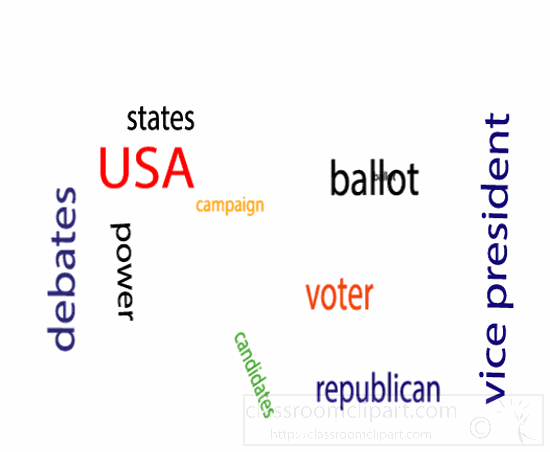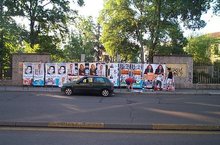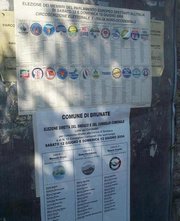Election
|
|
Electoral reform describes work to introduce fair and democratic electoral systems where they are not in place, or to improve the fairness or effectiveness of existing systems. Psephology is the study of results and other statistics relating to elections (especially with a view to predicting future results).
| Contents |
Definitions of democratic elections
In theory, the authority of the government in democracies derives solely from the consent of the governed. The principal mechanism for translating that consent into governmental authority is the holding of free and fair elections.

There is a broad consensus as to what kind of elections can be considered free and fair. Jeane Kirkpatrick, scholar and former United States ambassador to the United Nations, has offered this definition: "Democratic elections are not merely symbolic....They are competitive, periodic, inclusive, definitive elections in which the chief decision-makers in a government are selected by citizens who enjoy broad freedom to criticize government, to publish their criticism and to present alternatives."
The Democracy Watch (International) website, further defines fair democratic elections as, "Elections in which great care is taken to prevent any explicit or hidden structural bias towards any one candidate, aside from those beneficial biases that naturally result from an electorate that is equally well informed about the various assets and liabilities of each candidate". This was more formally stated in 2000 by Chief Justice Murray Gleeson of the Australian High Court as "The democratic and lawful means of securing change, if change be necessary, is an expression of the will of an informed electorate."
The apparently simple requirement of an informed electorate is difficult to achieve in modern electorates with thousands of voters, most of whom have no prospects of knowing candidates other than by information published by third parties. The party with the most immediate interest in having structural biases is the government conducting the election. One possible result is the 'show' elections described below.
Some other scholars argue that elections are at most secondary to a functioning democracy. They argue that the rule of law is more important. An example would be pre-unification Hong Kong, which was ruled by an unelected British administrator but was generally considered to be a free and open society due to its strong legal institutions.
Characteristics of elections
Who can vote
A crucial issue in elections is the question of suffrage—who is allowed to vote—whether the electorate comprises the entire citizenry or some subset of it. The democracy of ancient Athens did not allow women, children, foreigners and slaves from voting—thus disenfranchising the majority of the population. Over the last few centuries since elections began to be held there has been a long struggle to expand the franchise to excluded groups.
Originally in the U.S., for example, only white male property holders enjoyed the right to elect and be elected when the Constitution was signed in 1787. The property qualification disappeared by the early 19th century, and women won the right to vote in 1920. African Americans, however, did not enjoy full voting rights in the southern United States until the civil rights movement of the 1960s. And finally, in 1971, younger citizens were given the right to vote when the United States lowered the voting age from 21 to 18. In Canada First Nations were long denied the vote.
There are still many restrictions in place. Many countries do not allow those judged mentally incapable to vote, and some deny the vote to serving prisoners as well. In some cases, such as some U.S. states, convicted felons are also barred from voting upon release. Children are not permitted to vote in any country; however, the minimum voting age varies.
In some countries, voting is compulsory. If an eligible voter does not attend a polling place, they may be subject to punitive measures such as a small fine.
Who is voted for
In some states far more positions are filled through election than others.
In all democracies it is often the case that some powerful figures are not elected. Those institutions that were designed to not be too closely swayed by public opinion are often not elected. For instance judges are usually appointed for life, or until a specific age, to insulate them against popular pressure and help ensure their impartiality. This is often seen as an integral part of the separation of powers.
However, there are some counterexamples. In the United States some judges are elected, and in ancient Athens military generals were elected.
Also frequent is the erecting of an intermediate tier of electors between the people and the elected figure. For example, the President of the United States is not elected directly by the people but by the U.S. Electoral College, and U.S. Senators were originally chosen by the state legislatures. Also, in the Westminster System the Prime Minister, who holds the most power, is formally chosen by the head of state and in reality by the legislature or by their party.
Types of election
In most democratic political systems, there are a range of different types of election, corresponding to different layers of public governance or geographical jurisdiction. Some common types of election are:
Closely related to elections are referendums (or referenda) in which citizens can vote on specific laws and policies. Referendums are often added to an election ballot. Some areas have methods by which individuals can add measures to a ballot by petitions, but in most districts they are called by governments. Referendums are particularly prevalent and important in a direct democracy such as Switzerland.
Electoral systems
Electoral systems refer to the detailed constitutional arrangements and voting systems which convert the vote into a determination of which individuals and political parties are elected to positions of power.
The first step is to tally the votes, for which various different vote counting systems and ballot types are used. Voting systems then determine the result on the basis of the tally. Most systems can be categorized as either proportional or majoritarian. Among the former are party-list proportional representation and additional member system. Among the latter are First Past the Post (FPP) (relative majority) and absolute majority. Many countries have growing electoral reform movements, which advocate systems such as approval voting, single transferable vote, instant runoff voting or a Condorcet method.
While openness and accountability are usually considered cornerstones of a democratic system, the act of voting itself is usually an important exception. The secret ballot is a relatively modern development, but it is now considered crucial in most free and fair elections, as it limits the effectiveness of intimidation.
(See National electoral systems for individual electoral systems)
Scheduling
The nature of democracy is that elected officials are accountable to the people, and they must return to the voters at prescribed intervals to seek their mandate to continue in office. For that reason most democratic constitutions provide that elections are held at fixed regular intervals. In most states elections are held between every three and six years. There are exceptions to this; the U.S. House of Representives stands for election every two years, while the President of Ireland holds a largely ceremonial position for seven years.
Some nations have pre-determined and fixed election dates (e.g., the U.S.). This has the advantage of fairness and predictability. However, it tends to greatly lengthen campaigns, and makes dissolving the legislature more problematic if the date should happen to fall at time when dissolution is inconvenient. Other states (e.g., the United Kingdom) only set maximum time in office, and the executive decides exactly when within that limit it will actually go to the polls.
Difficulties with elections
Show elections
While all modern democracies hold regular elections, the converse is not true—not all elections are held by true democracies. Some governments employ other 'behind-the-scenes' means of candidate selection but organise a sham process that appears to be a genuine electoral contest, in order to present the facade of popular consent and support.
Dictatorships, such as the former Soviet Union, have been known to hold such show elections. In the 'single candidate' type of show-election, there may only be one candidate for any one given position, with no alternative choices for voters beyong voting yes or no to this candidate. In the 'fixed vote' type of show-election such elections may offer several candidates for each office. In both cases, the government uses intimidation or vote-rigging to ensure a high yes vote or that only the government-approved candidates are chosen.
Another model is the 'false diversity' type of show-election in which there may be several choices, all of which support the status quo. In theory, 'false diversity' elections would be recognised by a truly informed electorate but as noted above this may be impossible, for example where a government conducting elections also controls the media by which most voters are informed. Examples of this are given below.
Bias and limited options
Similar to the false diversity elections are those in which candidates are limited by undemocratic forces and biases. The Iranian form of government is an example of this. In the 2004 Iranian parliamentary elections almost all of the reformist candidates were ruled unfit by the Guardian Council of religious leaders. According to the Iranian constitution this was fully within the Council's constitutional rights, and designed to prevent enemies of the Islamic Revolution from coming to power.
Simply permitting the opposition access to the ballot is not enough. In order for democratic elections to be fair and competitive, opposition parties and candidates must enjoy the rights to freedom of speech, assembly, and movement as necessary to voice their criticisms of the government openly and to bring alternative policies and candidates to the voters. In states where these freedoms are not granted or where opposition party politicians are harassed and their events disrupted, elections will not reflect the legitimate views of the populace. A current example of such a state is Zimbabwe. In states with fragile democracies where there has been a history of political violence or blatantly unfair elections, international election observers are often called in by external bodies like the United Nations, and protected by foreign forces, to guarantee fairness.
In addition, elections in which opposition candidates are not given access to radio, newspaper and television coverage are also likely to be biased. An example of this kind of structural bias was the 2004 re-election of Russian president Vladimir Putin, in which the state controlled media consistently supported his election run, consistently condemned his opponents, provided virtually unlimited free advertising to Putin's campaign, and barred attempts by his opponents to run campaign advertisements. For this reason, many countries ensure equal air time to election ads from all sizeable parties and have systems that help pay for election advertising.
Some allege that beyond the examples given here, there are more subtle and systemic forms of 'false-diversity' in elections which are not generally recognised. Noam Chomsky and other progressives argue that in the West, and especially the U.S., powerful corporate interests behind the media act as a filter that only lets preordained views be heard by the public and excludes third parties and alternative viewpoints.
Corruption of democracies
The very openness of a democracy means that in many states it is possible for voters to vote to get rid of democracy itself.
Democracies have failed many times in history from ancient Greece to 18th and 19th century France (see Second Empire under Napoleon III), and perhaps most famously in 20th century Germany, when the Nazis initially came to power by democratic means (albeit by plurality vote). Throughout most of the developing world today democracies remain unstable, often collapsing to military coup or other forms of dictatorship. Thinkers such as Aristotle and many others long believed democracy to be inherently unstable and to always quickly collapse.
Most democracies have some form of separation of powers so that even if a tyrant is elected the constitution would still have to be obeyed, in theory at least. Of course, an elected government can change the constitution, but this can be made difficult by, in some cases, requiring a 2/3 majority in two consecutive elected governments—the actual requirements vary by each constitutional system.
To limit this danger the system used in many states indirectly places limits on how easily new parties can form. The "first past the post" electoral system makes it hard for new parties to quickly gain power. In states using proportional representation systems, there is a determined proportion of the popular vote that must be won before a party can be admitted to parliament.
Elections around the world
- See List of election results for an overview by country.
List of election advertising techniques
- Attack ad
- Canvassing
- Direct marketing
- Election promise
- Get out the vote
- Lawn sign
- Negative campaigning
- Opposition research
- PIG
- Push poll
See also
- Demarchy — "Democracy without Elections"
- Garrat Elections
- Gerontocracy
- Meritocracy
- Pluralism
- Political campaigning
- Political science
- Polling station
- Sortition
- Voter turnout



